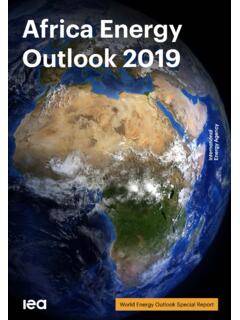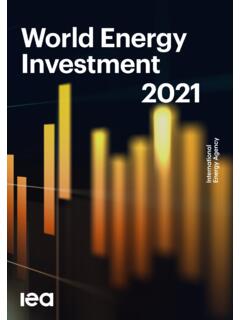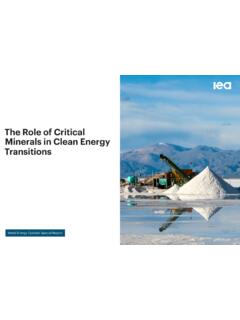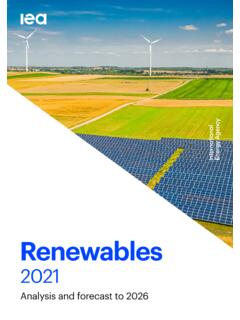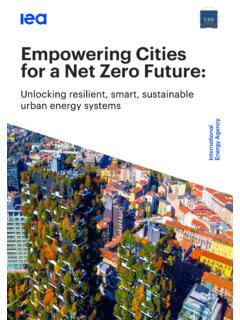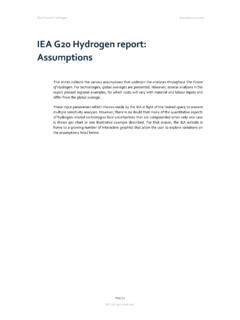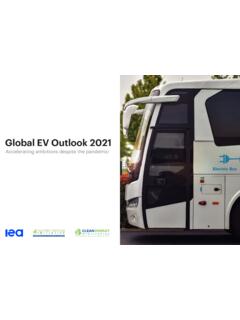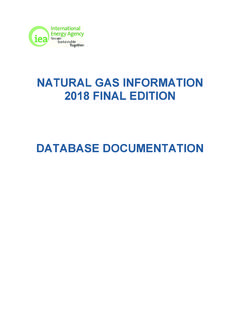Transcription of Energy and Carbon tracker - Users Guide - .NET Framework
1 Data serviceEnergy and Carbon tracker Users Guide 2020 editionEnergy and Carbon tracker Users Guide How to use this product PAGE | 1 IEA. All rights reserved. This document provides information regarding the 2020 edition of the International Energy Agency (IEA) Energy and Carbon tracker Excel database . This database can be found online at: We would like to hear your feedback on the type of variables and functionalities which if incorporated in the next editions of this product would be beneficial to your needs. Please address your inquiries to Please note that all IEA data are subject to the following Terms and Conditions found on the IEA website: Energy and Carbon tracker Users Guide Table of contents PAGE | 2 IEA. All rights reserved. Table of contents 1. database description .. 3 2.
2 How to use this product .. 4 Contents .. 5 Highlights .. 6 Country comparison .. 6 Emissions .. 8 Energy .. 9 10 Industry .. 11 Transport .. 12 Buildings .. 13 End use .. 14 Definitions .. 15 Geo coverage .. 15 Graph #_sheet xxx .. 16 Time series_Country comparison .. 17 Bar charts_Country comparison .. 17 3. Units and conversion .. 19 Decimal prefixes .. 20 Tonne of CO2 .. 20 4. Abbreviations .. 21 Energy and Carbon tracker Users Guide Table of contents PAGE | 3 IEA. All rights reserved. 1. database description Tracking progress in the transition to low- Carbon Energy systems provides valuable insight into the steps needed today to achieve both short- and long-term climate goals. The IEA Energy and Carbon tracker is a new interactive product showcasing a wide set of indicators to analyse historical trends of CO2 emissions, Energy , power and sectoral patterns at country level.
3 This product, published in Excel format, includes graphs of time series and decomposition analyses, and allows for country comparisons. The data are derived based on the 2020 editions of the following IEA databases: world Energy Balances, CO2 Emissions from Fuel Combustion and Energy Efficiency Indicators. The user -friendly design allows visual presentation of a set of analyses that help Users to track decarbonisation by country, as well as globally. The Energy and Carbon tracker includes annual data from 1990 to 2019 for selected indicators for all OECD countries, IEA family countries, and other selected countries; and data up to 2018 for the global set of indicators for over 160 countries and regions. The tracker includes graphs and data for the following indicators: CO2 emissions by sector and by product CO2 and Energy -related socio-economic indicators Total Energy supply by source and by product Sectoral shares in total final consumption Power generation and sectoral CO2 emissions by product Share of power generation by product Drivers of CO2 emissions from electricity generation Sectoral Energy consumption by product End-use Energy consumption by sector.
4 Energy and Carbon tracker Users Guide Table of contents PAGE | 4 IEA. All rights reserved. 2. How to use this product This section outlines the structure of the file and discusses its functionalities. The Excel file includes 12 main worksheets with compilations of interactive graphs by topic, which allow the user to select the country to be displayed and compared. In addition, there are 43 data worksheets, each which is accompanied by the underlying data associated with a given graph, in a simple table format. In each worksheet, Users can select the country to be displayed through a menu on the right side of the page. All the graphs on the sheet will automatically update, with the name of the country in the title. Figure 1 displays an example of the country menus, which enable Users to select a country and automatically update the graphs.
5 Figure 1 Example of a c ountry menu included on the main worksheets Users can easily access the underlying data for each graph by clicking on the relevant button under the country menu. Figure 2 shows an example of the buttons to access the underlying data for each individual graph. CountryWorldAfricaNon-OECD AmericasMiddle EastNon-OECD Europe and State of and HerzegovinaBotswanaBrazilBrunei DarussalamBulgariaCambodiaCameroonCanada ChilePeople's Republic of ChinaColombiaRepublic of the CongoCosta RicaCote d'IvoireCroatiaCubaCuracao/Netherlands RepublicDemocratic People's Republic of RepublicEcuadorEgyptEl SalvadorEquatorial GuineaEritreaEstoniaEthiopiaFinlandFranc eGabonGeorgiaGermanyGhanaGibraltarGreece GuatemalaHaitiHondurasHong Kong (China)HungaryIcelandIndiaIndonesiaIslam ic Republic of IranIraqIrelandIsraelItalyJamaicaJapanJo rdanKazakhstanKenyaKoreaKosovoKuwaitKyrg yzstanLao People's of MoldovaMongoliaMontenegroMoroccoMozambiq ueMyanmarNamibiaNepalNetherlandsNew ZealandNicaraguaNigerNigeriaRepublic of North FederationSaudi ArabiaSenegalSerbiaSingaporeSlovak RepublicSloveniaSouth AfricaSouth SudanSpainSri LankaSudanSurinameSwedenSwitzerlandSyria n Arab RepublicChinese TaipeiTajikistanUnited Republic of and TobagoTunisiaTurkeyTurkmenistanUkraineUn ited Arab EmiratesUnited KingdomUnited StatesUruguayUzbekistanBolivarian Republic of NamYemenZambiaZimbabweOther AfricaOther non-OECD AmericasOther non-OECD AsiaOECD TotalNon-OECD TotalIEA TotalIEA and Union - 28G20 Asia excluding ChinaChina (Region)
6 Energy and Carbon tracker Users Guide Table of contents PAGE | 5 IEA. All rights reserved. Figure 2 Example of the buttons included on the main worksheets for accessing data Note: Macros must be enabled for this file to work properly. The worksheets included in the file are: Contents The Contents sheet includes the table of contents, to help Users navigate through the Excel file, as well as a brief product description, links to the sources and supporting documentation. Figure 3 represents the structure of the Contents sheet. Figure 3 Structure of the Contents sheet Access the data underlying each graph by clicking on the respective button below:Graph 1 T otal CO2emissions from fuel combustion (MtCO2)Graph 2T otal CO emissions and driversindices (2000 = 100)Graph 3 Powergeneration CO2emissions (MtCO )Graph 4 Share in power generation (%)Graph 5 Carbon intensity of power index (2000=100)Graph 6 Carbonintensity of the economy (CO2/GDP)(kg CO per 2015 USD)Graph 7 Energy intensity of the economy (TES/GDP) (toe per thousand 2015 USD)Graph 8CO2emissions per population (tCO2per capita)Graph 9 Total Energy supply per population (toe per capita)
7 HighlightsSelected set of indicators with data up to comparisonProvides comparison among countries for a selected set of indicatoEmissionsSet of indicators tracking Carbon of indicators tracking of indicators tracking of indicators tracking of indicators tracking of indicators tracking use Set of indicators presenting end-use the variables presented in this coverageIncludes the regional Energy and Carbon tracker : Users Guide Energy and Carbon tracker (2020 edition)Table of contentsSources-IEA (2020), world Energy Balances ( database ).-IEA (2020), CO Emissions from Fuel Combustion ( database ).-IEA (2020), Energy Efficiency Indicators ( database ).Product descriptionThis product showcases a wide set of indicators to analyse historical trends of CO2emissions, Energy , power and sectoral patterns at country level.
8 It includes interactive graphs of time series and decomposition analyses, also allowing for country comparison. The indicators are derived based on data from the IEA " world Energy Balances", "CO2 Emissions from Fuel Combustion" and " Energy Efficiency Indicators" a general explanation of metrics, as well as time and geographical coverage, please refer to the Definitions for individual graphs are available in sheets named Graph xx_(Tab xxx) .For detailed guidance of how to use this file, please refer to the DocumentationFor detailed information on definitions, methodologies, sources and geographical coverage, please consult the following documentation:IEA world Energy BalancesIEA CO2 Emissions from Fuel CombustionIEA Energy Efficiency IndicatorsT&CsMore dataContact usHighlightsCountry comparisonEmissionsEnergyPowerIndustryTr ansportBuildingsEnd-useDefinitionsGeo coverageEnergy and Carbon tracker Users Guide Table of contents PAGE | 6 IEA.
9 All rights reserved. Highlights The Highlights sheet includes nine interactive graphs for a selected set of indicators, with data up to the most recent year. By selecting a country or region from the country list, the graphs display the corresponding indicators. Data for individual graphs are available in individual sheets labelled Graph #_Highlights and can be accessed by clicking on the relevant buttons. Figure 4 shows samples from the interactive graphs included on the Highlights sheet. Figure 4 Sample graphs from the Highlights sheet The full list of indicators included in this sheet includes: Total CO2 emissions from fuel combustion Total CO2 emissions and drivers indices Power generation CO2 emissions by product Share of power generation by product Carbon intensity of power index Carbon intensity of the economy Energy intensity of the economy CO2 emissions per population Total Energy supply (TES) per population.
10 Country comparison The Country comparison sheet includes 11 interactive graphs for a selected set of indicators, which allows for comparison among countries and regions. 60801001201401601802000 2001 2002 2003 2004 2005 2006 2007 2008 2009 2010 2011 2012 2013 2014 2015 2016 2017 2018 20192000 = 100 Total CO emissions and drivers indices, Brazil Carbon intensity (CO / TES)CO emissionsEnergy intensity (TES / GDP PPP)GDP Rights in power generation, BrazilRenewablesCoalOilNatural gasLow- Carbon Rights and Carbon tracker Users Guide Table of contents PAGE | 7 IEA. All rights reserved. By holding the Control key (CTRL) on the keyboard multiple countries/regions can be selected. Moreover, the year for the desired comparison can be selected for all graphs in bar format, while the time series graphs remain complete.
